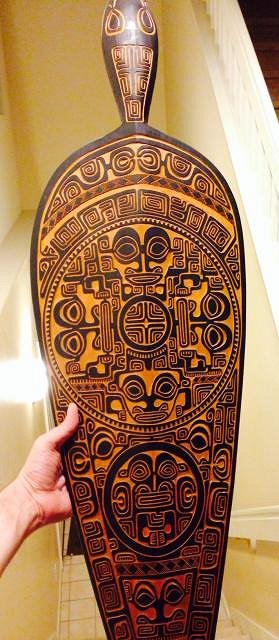Tiki Central / Collecting Tiki / Tiki Finds
Post #710003 by Trad'r Bill on Mon, Mar 3, 2014 3:59 PM
|
TB
Trad'r Bill
Posted
posted
on
Mon, Mar 3, 2014 3:59 PM
Sorry to clog up the thread but thought you would enjoy reading this email I received from Healane Kimitete, the granddaughter of the man who carved this paddle I recently found. Such a thoughtful email:
Aloha, Thank you so much for finding us. Wow, the last time I remembered seeing this was when I was a young girl at my grandparent's country home in Fa'aone, Tahiti. This brings back a lot of great memories but it also brings tears to my eyes and warmth to my heart remembering of his smile and laughter. He was so proud to share his many art pieces and stories to us. We would play outside, or go down to the riverside with my grandma to watch her feed her pet freshwater eel in the river. It would swim up sticking its head out of the water, swaying back and forth so beautifully in the river like it was dancing a mele hula / hula dance for her when it would hear her approach closely. My grandma would smile and giggle under her breath and speak in her native tongue (Marquesas language) to her pet eel like it was her own child. It would twist and turn its body and smile right back at her. I will never forget that moment, priceless.... You have a couple questions below: 2)Any info you have about the paddle would be great to have: There were many great stories and legends that were shared to us when we were little, for this one in particular he shared about a baby that was born on the island of Nuku Hiva, Marquesas, was born pepe 'e/different or odd. One half of its body was shape of a honu or turtle and the other half fafapiti or manta-ray. Normally in the olden days, if you were found with an deformed child, it would be killed or taken away from the parents, it was said, it would bring bad luck not only to the family but to the whole village. But for some reason, this family didn't say or speak to no one about there child and felt in there hearts, they were blessed and given this special child for a reason. They've nature d the child until it was able to move and take care itself on its own. The child promised his parents that he will watch and take care of them, the people and their children's of this village for saving and granting its life to live. Made sure they were happy, lived in peace and never go hungry. The child would only come out and walk the land at night, then right when the sun peaks over the mountains in the early morning, it would return back to the ocean. So if you look at the paddle, it signifies this child, the top half is the turtle and the bottom half is shape of a manta-ray. The carvings on its back and tail, signifies all the travels it has done through its life, and all the people he's come across with and that he has kept his promise, to watch over the lands and its people of Nuku Hiva.
I will end here, and want to thank you for taking the time to find us! To keep my grandpa and Dad's legacy alive, we've formed a canoe club called Kai'Ehitu meaning The Seven Seas or The Seventh Generations, we're a non-profit 501(c)3 organizations. Our focus is to give back to the community, children, youth, new members, adults and elders to share this great sport called canoe paddling. Aloha and mahalo nui ~ Healani Kimitete |

